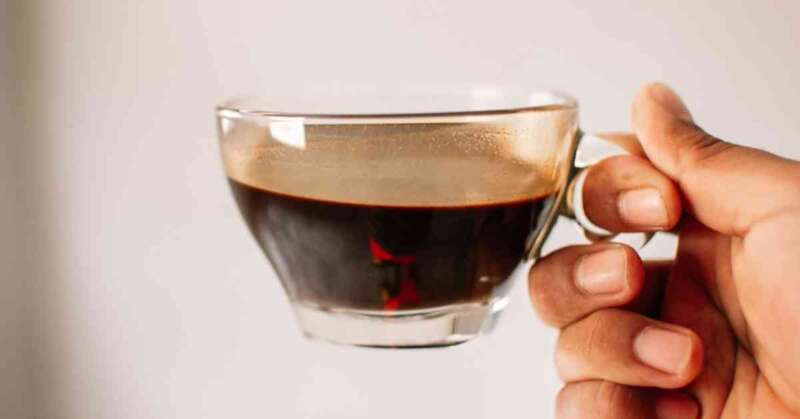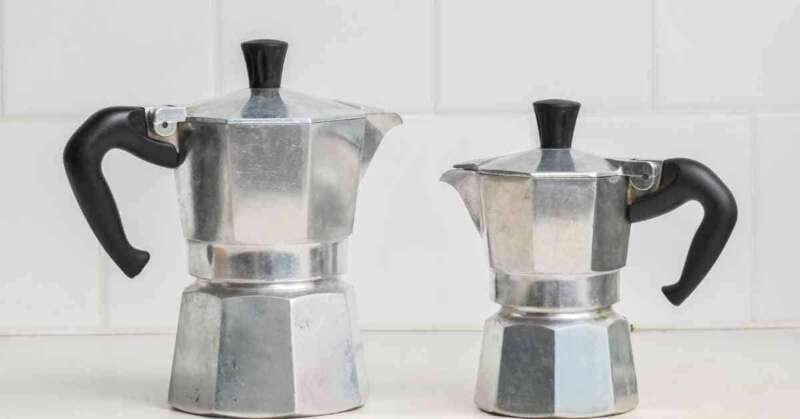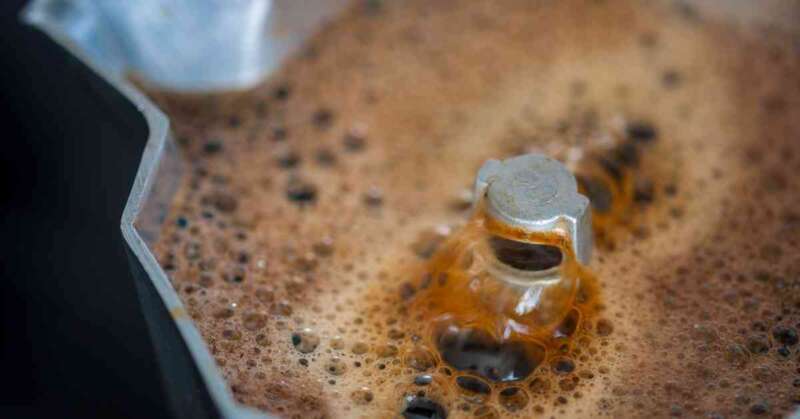You can have the best coffee maker in the world, but if you get the ratio of coffee grounds to water wrong, it can turn a delicious coffee into one that’s not so palatable.
Getting the balance right does make a big difference, so it’s worth the extra time and effort to measure and weigh.
Related: Knowledge is power. See our guide on how to use a moka pot for more information.
So, what is the correct coffee-to-water ratio for a Moka pot? Let’s find out in this Moka pot brew guide.
Moka Pot Coffee to Water Ratio:
Your stovetop coffee maker needs a precise ratio of ground coffee and water to make the best brew. Knowing how much coffee to put in is crucial.
Many people just throw in a load of ground coffee into the filter basket and hope for the best.
If you’re going to use a specialty coffee for brewing your moka coffee, precision is key to making the most out of it.
Simply put, a Moka pot needs a coffee-to-water ratio of 1:7. For each gram of coffee grounds you put into your Moka pot, you’ll need 7 grams of water.
With this ratio, you’ll get a rich, strong coffee.

Though this ratio is the best for brewing coffee, you can alter it according to individual tastes. For those who prefer a weaker and lighter coffee, you can use a ratio of 1:8 or 1:9 and add more water per grams of coffee.
Why Is the Moka Pot Coffee Ratio Important?
Because a Moka pot uses pressure from steam to force the hot water through the ground coffee, the amount of water in the pot matters.
Too much and your coffee will be watery and weak, too little and it will be bitter and strong.
Many people choose a ratio of 1:11 for Moka pot coffee and though you might think this is weak, it will depend on the coffee beans used and how fine or coarse the grind size is.
How to Get the Ratio Right
To ensure you have the correct ratio of coffee to water, you will need an ordinary kitchen scale and your clean Moka pot.
You’ll probably notice your Moka pot will have markings to indicate the maximum water level. Alternatively, you can use the inside valve as a reference point.
If there is no safety valve, you can just measure the water on the scales too. You’ll need to weigh the pot empty and then add in water until the desired weight is reached.
Here is an example:
If you want to produce one cup of coffee with your Moka pot, you’ll need 7 to 8 grams of coffee.
A Guide to Ratios
- 1 cup – 60 ml – 7-8g of coffee
- 3 cups – 130 ml – 15-20g of coffee
- 6 cups – 270 ml – 30-35g of coffee
- 9 cups – 420 ml – 50-55g of coffee
- 12 cups – 670 ml – 100g coffee
The Different Sizes of Moka Pot
A stovetop espresso maker is available in a range of different sizes, which makes it a really versatile piece of kit for your kitchen.
Moka pots are available as small as a one-cup machine and as large as twelve cups.

The most common size is likely the six-cup Moka pot. This size is ideal for most homes as it’s a great middle ground coffee maker. You can have more than one cup of coffee each and will always be able to get your coffee fix quickly.
The size of your Moka pot will affect the coffee to water ratio. Let’s look at this:
Ratio for A One-Cup Moka Pot
A 1-cup Moka pot will brew approximately 60 ml of coffee. This means we need between 7 and 8 grams of coffee for 60 ml water. This will give you a rich, robust coffee that isn’t bitter.
You should alter this slightly if you prefer using dark roasts. In this case, use a bit more coffee to bring out the flavor.
Ratio for Three-Cup Moka Pot
After the six cup, this is the most popular Moka pot size. With around 130 ml of brewed coffee, you’ll get enough coffee for two people.
With a pot this size, you should use 15 to 2- grams of coffee with 130 ml of water. You’ll get a full and flavorsome result.
Ratio for Six-Cup Moka Pot
For a six-cup moka pot, you’ll need between 30 and 35 grams of coffee grounds.
It can be harder with larger amounts because the ratios aren’t as straight forward. This is because the brewing process and heat also affect a lot of the balance.
It’s best to err on the side of caution and make a strong cup of coffee – there is nothing stopping you adding hot water to it if it’s too strong.
Ratio for Nine-Cup Moka Pot
This is arguably the largest size most people have around their home. With this size, you can brew around 420 ml of coffee. For this amount, between 50 g and 55 grams of coffee is ideal.
The coffee beans should be ground to a medium to fine grind and should not be tamped inside the filter basket.
Ratio for 12-Cup Moka Pot
If you’re a coffee enthusiast who’s looking to make coffee in batches (perhaps you like a party?), this size moka pot can make 630 ml in one go.
At this size, you’re going to need 100 grams of coffee.
As there is a lot of water, this will take a longer time to be ready than other sizes of moka pot.

Adjusting Your Coffee Brewing Methods and Ratio
As well as the coffee to water ratio, other things will affect the end result.
The type of beans and how they’re roasted and ground will affect the taste and strength too. It’s very common for baristas to alter their brewing methods depending on the beans they have in front of them. Professionals will alter their routine depending on the climate, soil and altitude where the coffee beans were grown.
The general consensus is that the beans grow faster and larger when they are grown at a lower altitude. Conversely, higher up, the bean grows more slowly and will be smaller.
This means that you might need to adjust the coffee grounds you put into your coffee machine.
Robusta beans, for example, are typically grown between 600 and 2,400 ft. Arabica beans are grown between 1,800 and 6,300 ft. The former are more rounded while the latter are more oval in shape.
All of these factors come into play when you’re deciding how much coffee to use. This is because when the beans are larger, there is a larger surface area for flavors to be extracted.
With smaller beans, the surfer area is reduced.
What This Means
What this boils down to is this:
- For Robusta beans, put more coffee in your filter basket
- For Arabica beans, use less coffee
This is, of course, just a rule of thumb, and there will be exceptions. The best option is to experiment with your coffee-to-water ratio to find the final brew that works best for your tastes.
Adjusting Your Ratio
The grind size also affects how much coffee grounds to put into your Moka pot. For a Moka pot, you should have a medium-fine grind size. This will be coarser (slightly) than your espresso grind and look like table salt.
If you’re not grinding your own whole beans, you should choose a pre-ground coffee that is an espresso grind, and these are usually slightly coarse, making them ideal for your Moka pot.
Related: Check out our guide on the best coffees for your Moka pot.
You can adjust your ratio by adding more ground coffee, water, or both when experimenting. It’s probably easier to adjust the water when you’re experimenting. This way, you’re only changing one variable each time.
Moreover, retaining the same amount of coffee in your filter basket will mean that you’ve always got enough resistance for the pressure to build up in the boiler chamber.
How Does the Heat Change the Brew?
Creating the perfect moka pot coffee is a fine art. Once you’ve got the brewing rations to perfection, you’ll still need to pay attention to timing and detail.
A moka pot should be put onto a medium heat if you want the best end result.
If you remove the moka pot from the heat too soon, you’ll have watery and weak coffee. Equally, if you leave it too long, you’ll have a burnt and bitter brew.
When going through a brewing cycle, you should watch until you see the first steam escaping from the moka pot spout. When you see this, remove your moka pot from the head and let it finish brewing.
Once you’ve left it for a minute after turning the heat off, you’ll have a perfect brewed coffee.
If you turn it off too prematurely, the water won’t extract the flavor of the coffee grounds fully.
You should also never leave your moka pot coffee on the stove to keep warm. A moka pot works to make coffee and isn’t design to keep it warm once it reaches the upper chamber.
Final Thoughts
This classic brewing method makes coffee taste great as long as you get the coffee to water ratio right. So, use a coffee scale, measure that water and make your perfect brew.
We hope our guide has helped you understand Moka pot coffee to water ratio requirements and how you can adjust them to tailor your cup of coffee to perfection. Happy brewing!
